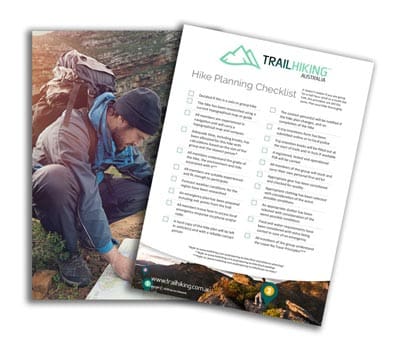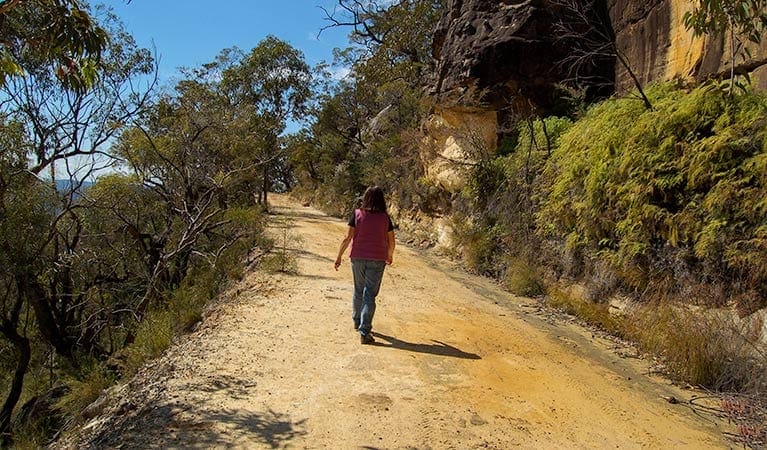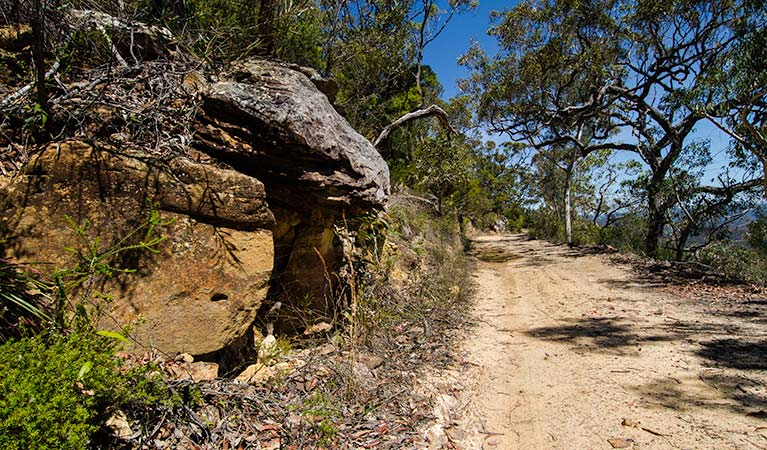Old Great North Road - World Heritage walk is a 9km, grade 4 hike located in Dharug National Park, New South Wales. The hike should take around 4 hours to complete.
Hike overview
Old Great North Road - World Heritage walk features a historic convict-built, some in chains, road overlooking the Hawkesbury River, in Dharug National Park. Returning via Finchs Line, this moderately steep track is popular with families and history buffs with some bushwalking experience.
Starting on Devines Hill loop, you'll pass the quarry, with historic graffiti carved in the rocks by convicts long gone. You can almost hear the sound of picks striking the blocks and the clinking of leg irons. Marvel at the craftsmanship of the beautifully preserved stonework that includes towering stone buttresses, culverts and even a curved wall. Unpack a picnic along the way and soak up the tranquil bush setting with scenic river views. Round off your day with a night under the stars at Mill Creek campground, only a short drive away.
Download the Convict Road app to learn about the hardships of the convicts who constructed the road. The app features two walks, short films about the convict experience, and expert commentary. Learn more about the World Heritage listing of Old Great North Road.
Take a virtual tour of Old Great North Road - World Heritage walk captured with Google Street View Trekker.
Route and GPX file
Help fellow hikers navigate with confidence. Share your GPX or KML file for this trail and help build a more comprehensive resource with precise waypoints and elevation profiles. Your contribution will empower adventurers with details they need for a safer and more enjoyable experience. I meticulously verify every file using official maps and surveys, ensuring the highest level of accuracy and reliability. Submit your file now and become a trailblazer for your fellow outdoor enthusiasts.
Tips
The weather in this area can be extreme and unpredictable, so please ensure you're well-prepared for your visit.
Bikes need to be walked down Devines Hill and the walking track section of Finchs Line.
Visit NSW National Parks and Wildlife Service for more information on this trail.
The longitude and latitude of the start and end points are approximately only and should not be used for navigation purposes. Please contact me if you know the correct coordinates.
Trail location
Sorry, no records were found. Please adjust your search criteria and try again.
Sorry, unable to load the Maps API.
Getting there
To Devines Hill loop trackhead. Old Great North Road - World Heritage walk starts at Devines Hill, 500m west of Wisemans Ferry, in Dharug National Park. To get there:From GosfordFollow the signs to Wisemans FerryDrive along Wisemans Ferry RoadPass the ferry crossing and drive approximately 500m to the bottom of Devines HillFrom SydneyFollow the signs to Wisemans FerryDriving along Old Northern RoadDrive through the town of Wisemans Ferry and cross the Hawkesbury River on the Wisemans FerryTurn left and drive approximately 500m to the bottom of Devines Hill or alternatively, park on the southern side and take the ferry over on foot. Park entry points Devines Hill loop trackhead See on map Parking Parking is limited near Devines Hill and Finchs Line, especially on weekends. It's recommended to park at Wisemans Ferry and travel across the ferry as a pedestrian.
Gallery
If you have any photos from this hike and are happy to share them, please upload your .jpg files here.
Please note: Uploading photos does not transfer ownership of copyright away from you. If requested, you will be credited for any photos you provide and can ask they be deleted at any time.
About the region
The Dharug National Park is a protected national park that is located in the Central Coast region of New South Wales, in eastern Australia. The 14,850-hectare national park is situated approximately 58 kilometres north of the Sydney central business district and 25 kilometres west of Gosford.
Similar trails nearby
Explore Safe
While planning your hike, it’s important to check official government sources for updated information, temporary closures and trail access requirements. Before hitting the trail, check local weather and bushfire advice for planned burns and bushfire warnings and let someone know before you go. Plan ahead and hike safely.
Let someone know
Adventure with peace of mind: Fill out your trip intentions form. Before you hit the trail, fill out an online form to privately send important details about your hike to your family or friends. If you don’t return on time, they can easily alert emergency services, preventing worry and ensuring a swift response. Hike with peace of mind and enjoy your outdoor adventure to the fullest. Be smart, be safe: Register your plans here.
Gear to consider

My free planning, food and packing checklists provide an introduction to things your could consider (as well as the Ten Essentials) on your day, overnight and multi-day adventures. Customise your kit according to your personal needs, always considering safety first.
Suggest an edit
Does this hikes information need updating? Sometimes the route, trail features or access conditions change.
Acknowledgement of Country
Trail Hiking Australia acknowledges the Traditional Owners of the lands on which we hike and pay respects to their Elders, past and present, and we acknowledge the First Nations people of other communities who may be here today.
















